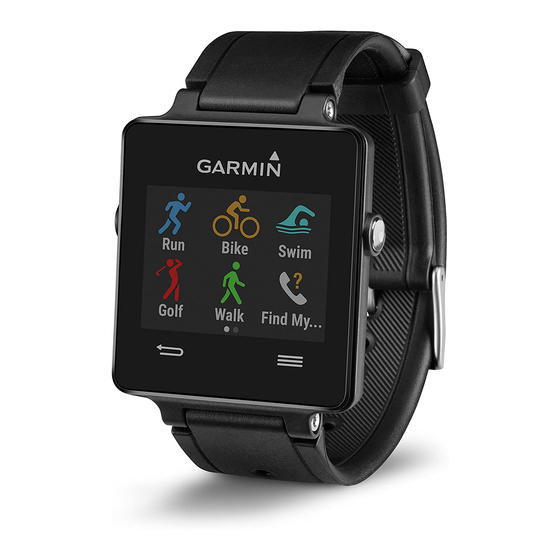Garmin vivoactive Manual del usuario - Página 11
Navegue en línea o descargue pdf Manual del usuario para Ver Garmin vivoactive. Garmin vivoactive 20 páginas.

most accurate calorie data during your activity, set your
maximum heart rate. You also can set each heart rate zone and
enter your resting heart rate manually. You can adjust your
zones manually on the device or using your Garmin Connect
account.
1
Select the action key.
2
Select System > User Profile > Heart Rate Zones.
3
Select Based On, and select an option.
• Select BPM to view and edit the zones in beats per
minute.
• Select %Max. HR to view and edit the zones as a
percentage of your maximum heart rate.
• Select %HRR to view and edit the zones as a percentage
of your heart rate reserve (maximum heart rate minus
resting heart rate).
4
Select Max. HR, and enter your maximum heart rate.
5
Select a zone, and enter a value for each zone.
6
Select Resting HR, and enter your resting heart rate.
About Heart Rate Zones
Many athletes use heart rate zones to measure and increase
their cardiovascular strength and improve their level of fitness. A
heart rate zone is a set range of heartbeats per minute. The five
commonly accepted heart rate zones are numbered from 1 to 5
according to increasing intensity. Generally, heart rate zones are
calculated based on percentages of your maximum heart rate.
Fitness Goals
Knowing your heart rate zones can help you measure and
improve your fitness by understanding and applying these
principles.
• Your heart rate is a good measure of exercise intensity.
• Training in certain heart rate zones can help you improve
cardiovascular capacity and strength.
• Knowing your heart rate zones can prevent you from
overtraining and can decrease your risk of injury.
If you know your maximum heart rate, you can use the table
(Heart Rate Zone
Calculations) to determine the best heart rate
zone for your fitness objectives.
If you do not know your maximum heart rate, use one of the
calculators available on the Internet. Some gyms and health
centers can provide a test that measures maximum heart rate.
The default maximum heart rate is 220 minus your age.
Tips for Erratic Heart Rate Data
If the heart rate data is erratic or does not appear, you can try
these tips.
• Reapply water to the electrodes and contact patches.
• Tighten the strap on your chest.
• Warm up for 5–10 minutes.
• Follow the care instructions
Monitor).
• Wear a cotton shirt or thoroughly wet both sides of the strap.
Synthetic fabrics that rub or flap against the heart rate
monitor can create static electricity that interferes with heart
rate signals.
• Move away from sources that can interfere with your heart
rate monitor.
Sources of interference may include strong electromagnetic
fields, some 2.4 GHz wireless sensors, high-voltage power
lines, electric motors, ovens, microwave ovens, 2.4 GHz
cordless phones, and wireless LAN access points.
Foot Pod
Your device is compatible with the foot pod. You can use the
foot pod to record pace and distance instead of using GPS when
Customizing Your Device
(Caring for the Heart Rate
you are training indoors or when your GPS signal is weak. The
foot pod is on standby and ready to send data (like the heart
rate monitor).
After 30 minutes of inactivity, the foot pod powers off to
conserve the battery. When the battery is low, a message
appears on your device. Approximately five hours of battery life
remain.
Calibrating Your Foot Pod
Before you can calibrate your foot pod, you must pair your
device with the foot pod
(Pairing ANT+
Manual calibration is recommended if you know your calibration
factor. If you have calibrated a foot pod with another Garmin
product, you may know your calibration factor.
1
Select the action key.
2
Select System > Sensors > Foot Pod > Calibration Factor.
3
Adjust the calibration factor:
• Increase the calibration factor if your distance is too low.
• Decrease the calibration factor if your distance is too high.
Using an Optional Bike Speed or Cadence
Sensor
You can use a compatible bike speed or cadence sensor to
send data to your device.
• Pair the sensor with your device
• Update your fitness user profile information
User
Profile).
• Set your wheel size
(Calibrating Your Speed
• Go for a ride
(Going for a
Calibrating Your Speed Sensor
Before you can calibrate your speed sensor, you must pair your
device with a compatible speed sensor
Manual calibration is optional and can improve accuracy.
1
Select the action key.
2
Select System > Sensors > Speed/Cadence > Wheel Size.
3
Select an option:
• Select Auto to automatically calculate your wheel size and
calibrate your speed sensor.
• Select Manual, and enter your wheel size to manually
calibrate your speed sensor
Circumference).
tempe
™
The tempe is an ANT+ wireless temperature sensor. You can
attach the sensor to a secure strap or loop where it is exposed
to ambient air, and therefore, provides a consistent source of
accurate temperature data. You must pair the tempe with your
device to display temperature data from the tempe.
Customizing Your Device
Changing the Watch Face
You can use the default digital watch face or a Connect IQ
watch face
(Downloading Connect IQ
1
Select the action key.
2
Select System > Watch Face.
3
Select an option.
Setting Up Your User Profile
You can update your gender, birth year, height, weight, and
heart rate zone
(Setting Your Heart Rate
device uses this information to calculate accurate training data.
Sensors).
(Pairing ANT+
Sensors).
(Setting Up Your
Sensor).
Ride).
(Pairing ANT+
Sensors).
(Wheel Size and
Features).
Zones) settings. The
7
